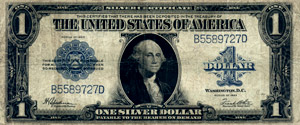
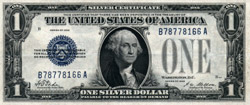


In July 1929, after years of discussion and months of preparation, the first small-size U.S. currency was placed into circulation. The new notes were about 25% smaller than previous issues. The change was intended primarily to reduce the cost of currency production; but it was also used as an opportunity to redesign all the notes in a uniform style, standardise designs for each denomination across all types, and introduce color-coded seals and serial numbers for each type.
When the new currency was released, the only notes available at first were the $1 Silver Certificate, the $2 U.S. Note, and the $5, $10, and $20 Federal Reserve Notes on all twelve districts. The $5 USN and the $10 and $20 Gold Certificates followed shortly after, and then the FRNs and GCs in denominations of $50 and higher came off the presses, one by one. By the end of 1929, all of these were available for circulation, and the older large-size notes were already in the minority. It would, however, take months longer for the National Currency to complete the transition to the new designs.
Typical note designs, Series 1928 | |
 Silver
Certificate |
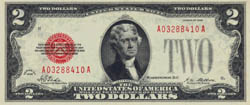 United States
Note |
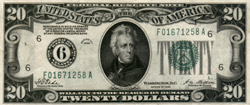 Federal Reserve
Note |
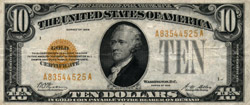 Gold
Certificate |
The first issues of small-size Silver Certificates, United States Notes, Federal Reserve Notes, and Gold Certificates were all dated Series 1928; their designs were all broadly similar, but differed in some details. The FRNs had the green Treasury seal on the right side of each note, and the black Fed seal (containing the number of the issuing Fed district on the $5 through $100, or the letter of the Fed district on the $500 and up) on the left side, with the legend above it. The other three types all had the colored Treasury seal at left, overlying the legend, which was centered on that side; on these notes, the right field was occupied only by the large spelled-out denomination, with no overprinting. (On notes of $100 and $500, the denomination was given in figures instead of spelled out; on notes of $1000 and higher, no indication of the denomination was printed in the right field.) All notes had the inscription "Washington, D.C." at the bottom on the right, between the base of the central portrait and the Secretary's signature. Most notes had the type designation located at the top center; but the GCs had it at left instead, surrounding the legend.
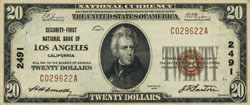
The first issue of small-size National Currency was dated Series 1929, and used a different set of designs than all the other types. These designs differed in that their engraved borders were smaller and simpler, allowing more open space on the face of the notes for the bank information and the two additional signatures that the Nationals carried. The Treasury seal was smaller than on the other currency types, and both the seal and the legend were overlaid on the large spelled-out denomination at right, leaving the left side of the note free for the title and location of the issuing bank. The "Washington, D.C." inscription was omitted.
Only one back design was prepared for each denomination, and all notes had their backs printed in green, so all differences between the types were confined to the face sides of the notes.
The obligations and legends on these notes were as follows:
Next: Early adjustments